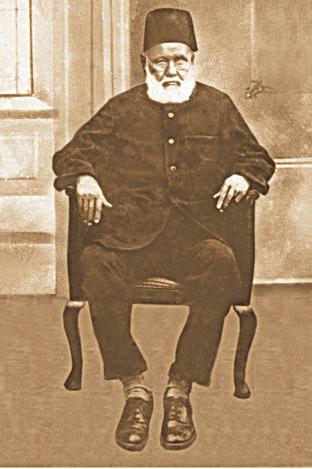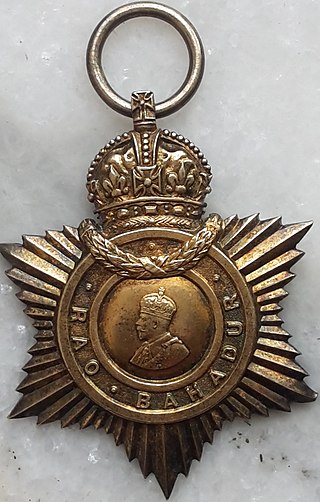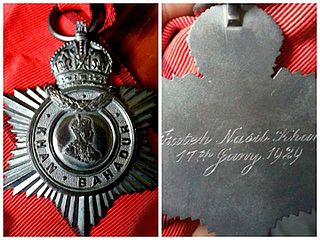Related Research Articles

Bankim Chandra Chattopadhyay CIE was an Indian novelist, poet, essayist and journalist. He was the author of the 1882 Bengali language novel Anandamath, which is one of the landmarks of modern Bengali and Indian literature. He was the composer of Vande Mataram, written in highly sanskritized Bengali, personifying Bengal as a mother goddess and inspiring activists during the Indian Independence Movement. Chattopadhayay wrote fourteen novels and many serious, serio-comic, satirical, scientific and critical treatises in Bengali. He is known as Sahitya Samrat in Bengali.
Kristo Das Pal, was an Indian journalist, orator and the editor of the Hindoo Patriot. In spite of being born of the Teli or oil-men's caste, which ranks low in the Hindu social hierarchy, he rose to be one of the important persons of his age.

Khan Bahadur Qazi Azizul Haque was a Bengali inventor and police officer in British India, notable for his work with Edward Henry and Hem Chandra Bose in developing the Henry Classification System of fingerprints, which is still in use. Haque provided the mathematical basis for the system.

Rai Bahadur Dinesh Chandra Sen was a Bengali writer, educationist and researcher of Bengali folklore from the Indian subcontinent. He was the founding faculty member and the Ramtanu Lahiri Research Fellow of the Department of Bengali Language and Literature of the University of Calcutta. He died in Calcutta in 1939.

Rao Bahadur and Rai Bahadur, abbreviatedR.B., was a title of honour bestowed during British rule in India to individuals for faithful service or acts of public welfare to the Empire. From 1911, the title was accompanied by a medal called a Title Badge. Translated, Rao means "prince", and Bahadur means "brave" or "most honourable". Bestowed mainly on Hindus, the equivalent title for Muslim and Parsi subjects was Khan Bahadur. For Sikhs it was Sardar Bahadur.

Romesh Chunder Dutt was an Indian civil servant, economic historian, translator of Ramayana and Mahabharata. He was one of the prominent proponents of Indian economic nationalism.
Rai Bahadur Hem Chandra Bose (1867-1949) was an Indian police officer and mathematician at the Calcutta Anthropometric Bureau. Supervised by Edward Henry, he and Azizul Haque developed the Henry Classification System for cataloging fingerprints.

Rai Sahib / Rao Saheb / Roy Sahib / Rao Sahib abbreviated R.S., was a title of honour issued during the era of British rule in India to individuals who performed faithful service or acts of public welfare to the nation. From 1911 the title was accompanied by a special Title Badge. Translated, Rai means "King" sahib means "leader". awarded during the reign of George VI. For another image of the badge see link This was the start level title usually awarded to civilians, which could later be upgraded to Rao Bahadur and then to Dewan Bahadur titles.
The New Year Honours were appointments by King George V to various orders and honours to reward and highlight good works by citizens of the United Kingdom and British Empire. They were announced on 31 December 1926.
The New Year Honours 1913 were appointments by King George V to various orders and honours to reward and highlight good works by members of the British Empire. They were announced on 3 January 1913.
The New Year Honours 1909 were appointments by King Edward VII to various orders and honours to reward and highlight good works by members of the British Empire. They were announced on 5 January 1909.
The 1931 New Year Honours were appointments by King George V to various orders and honours to reward and highlight good works by citizens of the United Kingdom and British Empire. They were announced on 30 December 1930.
The New Year Honours 1925 were appointments by King George V to various orders and honours to reward and highlight good works by members of the British Empire. They were published on 30 December 1924.
The New Year Honours 1921 were appointments by King George V to various orders and honours to reward and highlight good works by members of the British Empire. They were published on 31 December 1920.

Khan Bahadur – a compound of khan ('leader') and bahadur ('brave') – was a formal title of respect and honor, which was conferred exclusively on Muslim and other non-Hindu natives of British India. It was one degree higher than the title of Khan Sahib.
The 1933 New Year Honours were appointments by King George V to various orders and honours to reward and highlight good works by citizens of the United Kingdom and British Empire. They were announced on 30 December 1932.
The 1934 New Year Honours were appointments by King George V to various orders and honours to reward and highlight good works by citizens of the United Kingdom and British Empire. They were announced on 29 December 1933.
The 1936 New Year Honours were appointments by King George V to various orders and honours to reward and highlight good works by citizens of the United Kingdom and British Empire. They were announced on 31 December 1935.
The New Year Honours 1905, announced at the time as the Indian Honours, were appointments to various orders and honours of the United Kingdom and British India. The list was published in The Times on 2 January 1905, and the various honours were gazetted in The London Gazette on the following day.
The 1911 Delhi Durbar was held in December 1911 following the coronation in London in June of that year of King George V and Queen Mary. The King and Queen travelled to Delhi for the Durbar. For the occasion, the statutory limits of the membership of the Order of the Star of India and the Order of the Indian Empire were increased and many appointments were made to these and other orders. These honours were published in a supplement to the London Gazette dated 8 December 1911.
References
- 1 2 3 4 5 6 7 8 9 The Modern Review, Volume 72 by Ramananda Chatterjee. Prabasi Press. 1942. pp. 179–180.
- ↑ De, Amaledndu (1996). Raja Subodh Chandra Mallik and his times. National Council of Education, Bengal. p. 96.
- ↑ The Modern Review by Ramananda Chatterjee - 1959- Volume 106 - Page 287.
- ↑ Terrorism in Bengal: Terrorists outside Bengal deriving inspiration from and having links with Bengal terrorists by Amiya K. Samanta, Government of West Bengal, 1995 - Page 107
- ↑ The Criminal Law Review - Volume 9, 1918 - Page 49
- ↑ London Gazette 1911